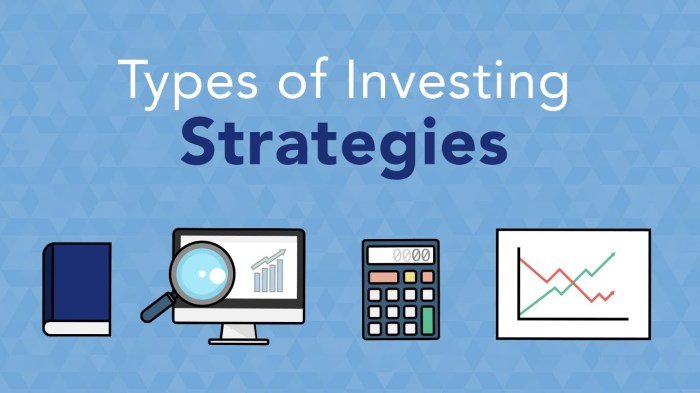Delving into the realm of stock share investment strategies for global investors, this guide aims to provide valuable insights and practical tips to navigate the complex world of investments.
Exploring various aspects of investment strategies, we uncover the intricacies of fundamental and technical analysis, risk management techniques, and tailored approaches for emerging markets and sector-specific investments.
Stock Share Investment Strategies for Global Investors

Investing in stock shares requires a well-thought-out strategy to maximize returns and manage risks effectively. Global investors utilize various strategies to achieve their investment goals, ranging from long-term value investing to short-term trading based on market trends.
Popular Stock Share Investment Strategies
- Value Investing:This strategy involves identifying undervalued stocks with strong fundamentals and holding them for the long term, anticipating their value to increase over time.
- Growth Investing:Investors using this strategy focus on companies with high growth potential, even if their current valuations are high, aiming to benefit from future growth in earnings and stock prices.
- Dividend Investing:This strategy revolves around investing in companies that regularly pay dividends, providing a steady income stream for investors in addition to potential capital appreciation.
- Momentum Investing:Investors following this strategy buy stocks that have shown upward momentum in their prices, expecting the trend to continue in the short term before selling for a profit.
Importance of Diversification in Stock Share Investment Strategies
Diversification is crucial for global investors to reduce risk exposure and protect their portfolios from market volatility. By spreading investments across different asset classes, industries, and regions, investors can minimize the impact of negative events on any single investment. This strategy helps to achieve a balance between risk and return, ensuring a more stable and resilient investment portfolio.
Fundamental Analysis
Fundamental analysis is a method used by investors to evaluate the intrinsic value of a stock by analyzing various financial and economic factors that could affect its price in the future. This type of analysis involves examining a company's financial statements, management team, industry outlook, and overall economic environment to determine whether a stock is undervalued or overvalued.
Key Financial Metrics Used in Fundamental Analysis
Fundamental analysis relies on a variety of key financial metrics to assess the health and performance of a company. Some of the most commonly used metrics include:
- 1. Price-to-Earnings (P/E) Ratio: This ratio compares a company's stock price to its earnings per share, indicating whether a stock is overvalued or undervalued relative to its earnings.
- 2. Earnings Per Share (EPS): EPS is a company's profit divided by its outstanding shares, showing how much profit each shareholder would receive if all profits were distributed.
- 3. Return on Equity (ROE): ROE measures a company's profitability by comparing net income to shareholders' equity, showing how well a company generates profits from shareholders' investments.
- 4. Debt-to-Equity Ratio: This ratio reveals a company's level of debt relative to equity, indicating its financial leverage and risk exposure.
- 5. Dividend Yield: Dividend yield shows the percentage of a company's dividend payments relative to its stock price, making it a crucial metric for income-seeking investors.
Technical Analysis
In stock share investment strategies, technical analysis plays a crucial role in helping investors make informed decisions based on historical price movements and trading volumes rather than solely on fundamental factors such as financial statements and economic indicators.
Common Technical Indicators
Technical analysts use a variety of indicators to analyze stock price movements and identify potential trends. Some common technical indicators used by global investors include:
- Simple Moving Average (SMA): A trend-following indicator that smooths out price data to identify trends over a specific period.
- Relative Strength Index (RSI): A momentum oscillator that measures the speed and change of price movements to determine overbought or oversold conditions.
- Bollinger Bands: Volatility bands placed above and below a moving average to indicate overbought or oversold conditions.
- MACD (Moving Average Convergence Divergence): A trend-following momentum indicator that shows the relationship between two moving averages of a security's price.
Impact of Global Events on Technical Analysis
Global events such as geopolitical tensions, economic data releases, and natural disasters can significantly impact technical analysis in stock share investments. These events can lead to sudden price movements, increased volatility, and changes in market sentiment, all of which can influence the effectiveness of technical indicators.
Emerging Markets Investment Strategies
Investing in emerging markets can offer great opportunities for global investors looking to diversify their portfolios and capitalize on high growth potential. However, it also comes with its own set of risks and challenges that need to be carefully navigated.
In this section, we will explore key factors to consider when implementing stock share investment strategies in emerging markets, discuss the risks and benefits associated with investing in these markets, and provide examples of successful strategies tailored for emerging markets.
Key Factors to Consider in Emerging Markets
- Political stability and regulatory environment: Political instability and unpredictable regulatory changes can significantly impact investments in emerging markets.
- Economic indicators: Understanding the economic conditions, growth prospects, inflation rates, and currency stability of the country is crucial for making informed investment decisions.
- Market liquidity and trading volumes: Limited liquidity in emerging markets can lead to higher volatility and wider bid-ask spreads, affecting the execution of trades.
- Sector-specific opportunities: Identifying sectors with strong growth potential in emerging markets can help investors capitalize on emerging trends and opportunities.
Risks and Benefits of Investing in Emerging Markets
- Risks:Currency risk, political instability, regulatory changes, liquidity risk, and corporate governance issues are some of the key risks associated with investing in emerging markets.
- Benefits:High growth potential, diversification opportunities, access to untapped markets, and attractive valuations are some of the benefits that attract investors to emerging markets.
Examples of Successful Investment Strategies in Emerging Markets
- Bottom-up approach:Identifying individual companies with strong fundamentals and growth potential in emerging markets can lead to successful long-term investments.
- Top-down approach:Analyzing macroeconomic trends, political developments, and sectoral shifts in emerging markets can help investors allocate their capital strategically.
- Opportunistic investing:Taking advantage of market dislocations, temporary setbacks, or undervalued assets in emerging markets can provide lucrative investment opportunities for investors with a high risk tolerance.
Sector-Specific Investment Strategies
When it comes to stock share investment strategies, sector-specific strategies focus on investing in specific sectors of the economy rather than individual companies. This approach allows investors to capitalize on the growth potential of particular industries or areas of the market.
Key Sectors for Global Investors
- Technology: The technology sector is a favorite among global investors due to its potential for innovation and high growth. Companies in this sector often lead the way in terms of new developments and disruptive technologies.
- Healthcare: Healthcare is considered a defensive sector, as demand for healthcare products and services remains relatively stable regardless of economic conditions. This sector is popular for its stability and long-term growth potential.
- Energy: The energy sector includes companies involved in oil, gas, renewable energy, and utilities. Global investors often look to this sector for diversification and exposure to commodities.
Analyzing and Choosing Sectors
- Market Trends: Analyze market trends and economic indicators to identify sectors that are poised for growth. Look for sectors with strong fundamentals and positive outlooks.
- Company Performance: Evaluate the performance of companies within a sector to gauge their financial health and growth potential. Consider factors such as revenue, earnings, and market share.
- Risk Assessment: Assess the risks associated with investing in specific sectors, including regulatory changes, competition, and market volatility. Diversification across sectors can help mitigate risk.
Risk Management Strategies
Risk management plays a crucial role in stock share investment strategies for global investors. It involves identifying, assessing, and prioritizing risks, followed by the application of resources to minimize, control, and monitor the impact of these risks. Effective risk management can help investors protect their investments and achieve their financial goals in the long run.
Importance of Risk Management in Stock Share Investments
- One of the key benefits of risk management is the protection of capital. By implementing risk management strategies, investors can minimize the potential losses that may arise from market fluctuations or unforeseen events.
- Additionally, risk management helps investors make informed decisions by evaluating the risks associated with different investment opportunities. This enables them to optimize their portfolio and enhance their overall returns.
- Furthermore, proper risk management can increase investor confidence and reduce emotional decision-making, leading to a more disciplined and strategic approach to investing.
Risk Management Techniques in Stock Share Investments
- Diversification:Spreading investments across different asset classes, industries, and geographic regions can help reduce concentration risk and potential losses.
- Stop-Loss Orders:Setting predefined price levels at which to sell a security can help limit losses and protect capital in case of adverse market movements.
- Hedging:Using derivatives or other financial instruments to offset potential losses in a particular investment can help mitigate risk exposure.
Impact of Geopolitical Events on Risk Management Strategies
- Geopolitical events such as trade disputes, political instability, or natural disasters can significantly impact financial markets and investment portfolios.
- Global investors need to stay informed about geopolitical developments and assess the potential risks they pose to their investments.
- Adjusting portfolio allocations, hedging against specific risks, or implementing defensive strategies can help mitigate the impact of geopolitical events on investment portfolios.
Ending Remarks
In conclusion, mastering stock share investment strategies is crucial for global investors looking to build a diverse and robust portfolio. By understanding the nuances of different strategies and risk management, investors can make informed decisions to maximize returns and mitigate potential losses in the dynamic world of stock markets.
Questions Often Asked
What are the benefits of diversification in stock share investment strategies?
Diversification helps spread risk across different assets, reducing the impact of a single investment underperforming on the overall portfolio.
How do geopolitical events affect risk management strategies for global investors?
Geopolitical events can introduce uncertainty and volatility in the market, prompting investors to adjust risk management techniques to protect their investments.
Which key financial metrics are commonly used in fundamental analysis for stock share investments?
Key financial metrics such as earnings per share (EPS), price-to-earnings (P/E) ratio, and return on equity (ROE) are often utilized in fundamental analysis.
What are some common technical indicators used by global investors in technical analysis?
Popular technical indicators include moving averages, relative strength index (RSI), and Bollinger Bands.






